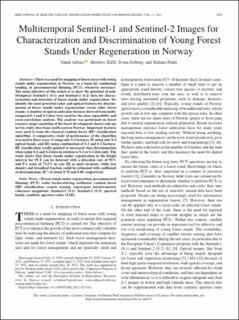| dc.contributor.author | Akbari, Vahid | |
| dc.contributor.author | Solberg, Svein | |
| dc.contributor.author | Puliti, Stefano | |
| dc.date.accessioned | 2021-10-08T08:47:31Z | |
| dc.date.available | 2021-10-08T08:47:31Z | |
| dc.date.created | 2021-09-13T18:28:25Z | |
| dc.date.issued | 2021-04-15 | |
| dc.identifier.citation | V. Akbari, S. Solberg and S. Puliti, "Multitemporal Sentinel-1 and Sentinel-2 Images for Characterization and Discrimination of Young Forest Stands Under Regeneration in Norway," in IEEE Journal of Selected Topics in Applied Earth Observations and Remote Sensing, vol. 14, pp. 5049-5063, 2021 | en_US |
| dc.identifier.issn | 1939-1404 | |
| dc.identifier.uri | https://hdl.handle.net/11250/2788634 | |
| dc.description.abstract | There is a need for mapping of forest areas with young stands under regeneration in Norway, as a basis for conducting tending, or precommercial thinning (PCT), whenever necessary. The main objective of this article is to show the potential of multitemporal Sentinel-1 (S-1) and Sentinel-2 (S-2) data for characterization and detection of forest stands under regeneration. We identify the most powerful radar and optical features for discrimination of forest stands under regeneration versus other forest stands. A number of optical and radar features derived from multitemporal S-1 and S-2 data were used for the class separability and cross-correlation analysis. The analysis was performed on forest resource maps consisting of the forest development classes and age in two study sites from south-eastern Norway. Important features were used to train the classical random forest (RF) classification algorithm. A comparative study of performance of the algorithm was used in three cases: I) using only S-1 features, II) using only S-2 optical bands, and III) using combination of S-1 and S-2 features. RF classification results pointed to increased class discrimination when using S-1 and S-2 data in relation to S-1 or S-2 data only. The study shows that forest stands under regeneration in the height interval for PCT can be detected with a detection rate of 91% and F-1 score of 73.2% in case III as most accurate, while tree density and broadleaf fraction could be estimated with coefficient of determination ( R2 ) of about 0.70 and 0.80, respectively. | en_US |
| dc.language.iso | eng | en_US |
| dc.publisher | IEEE | en_US |
| dc.rights | Attribution-NonCommercial-NoDerivatives 4.0 Internasjonal | * |
| dc.rights.uri | http://creativecommons.org/licenses/by-nc-nd/4.0/deed.no | * |
| dc.title | Multitemporal Sentinel-1 and Sentinel-2 Images for Characterization and Discrimination of Young Forest Stands Under Regeneration in Norway | en_US |
| dc.type | Peer reviewed | en_US |
| dc.type | Journal article | en_US |
| dc.description.version | publishedVersion | en_US |
| dc.rights.holder | © 2021 The author(s) | en_US |
| dc.source.pagenumber | 5049-5063 | en_US |
| dc.source.volume | 14 | en_US |
| dc.source.journal | IEEE Journal of Selected Topics in Applied Earth Observations and Remote Sensing | en_US |
| dc.identifier.doi | 10.1109/JSTARS.2021.3073101 | |
| dc.identifier.cristin | 1933926 | |
| dc.relation.project | Copernicus Program in Norway: 51567 | en_US |
| cristin.ispublished | true | |
| cristin.fulltext | original | |
| cristin.qualitycode | 1 | |

